Guitar
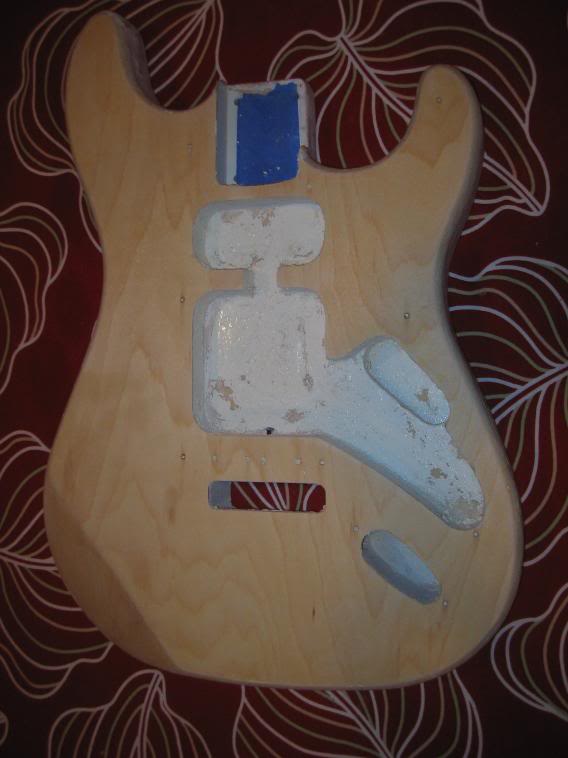
This post will hopefully guide the reader through the entire process for doing an accurate 1960s style Fender 3-color sunburst finish.
A customer asked me if it was possible to refinish his cream white Peavey Predator in a classic Fender-style 3-color sunburst. I explained that it might not be possible if I couldn't cleanly strip the existing finish off the Peavey and also, I had no idea what kind of wood was under the existing finish. We agreed that once I made an attempt at stripping the body we would talk and re-evaluate the options - the backup plan was to spray a Daphne Blue finish on the body.
The first step was to strip the body - always my least favorite step. I was pleasantly surprised when the cream finish did bubble up and peel away. The underlying primer coat was a little tougher, but eventually most of it came off, leaving some white finish on the body edges and cutaways.
A bit more hand sanding and a few passes with a random orbital sander cleaned up the body nicely - revealing a veneered birch or maple top and back. The only issue was at the front and back contours, which were obviously not veneered and therefore had a slightly different appearance.

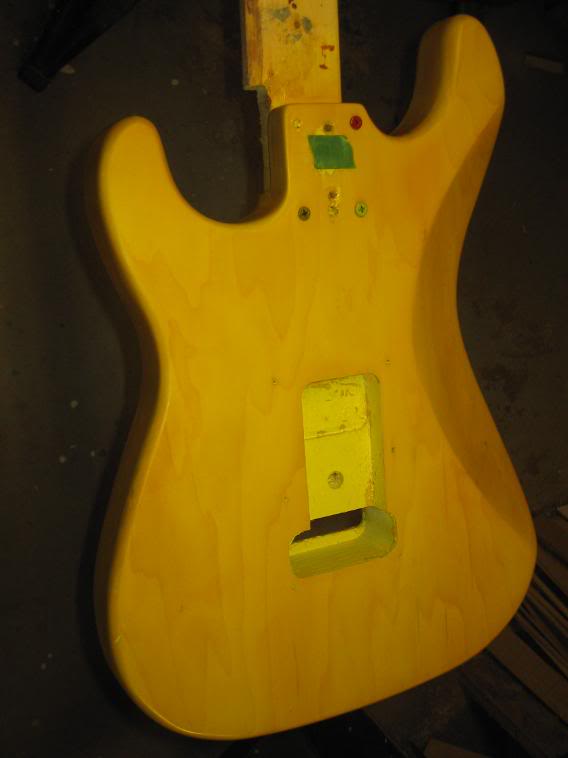
Much of the factory sealer coat was still on the wood, so a few coats of clear nitro were applied, rather than the vinyl undercoat that would be required on bare wood. After these coats were lightly sanded, the first tinted coat was applied - the base of the 3-color sunburst. This coat was clear gloss nitro tinted with equal parts of vintage amber and lemon yellow dye, with a drop of orange added. Several coats were sprayed till an even fairly rich color was achieved - though it still looked lighter and brighter than I was accustomed to seeing on 3-color Fenders.
A clear coat was applied over this, so that if I messed up the next two colors of the burst I would have the option of wetsanding off those coats and giving it another try. The body was lightly wet sanded to remove and unevenness and smooth out any orange peel.
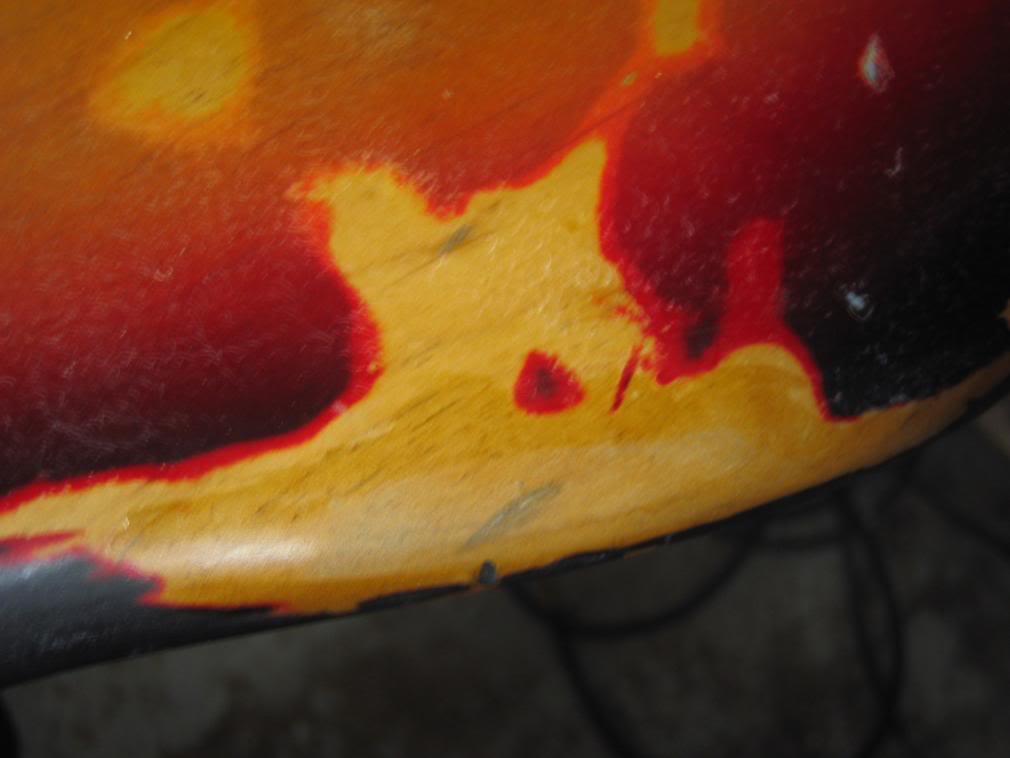
For the next step - I used an old beat up early 70's P-bass body as a reference. I was fairly certain that the sequence of finishing was: yellow, red, then walnut - but one site (maybe ReRanch) implied that the red could be done AFTER the walnut. However, the worn edges of the P-bass clearly illustrate a BRIGHT cherry red layer UNDER the almost black edge color.
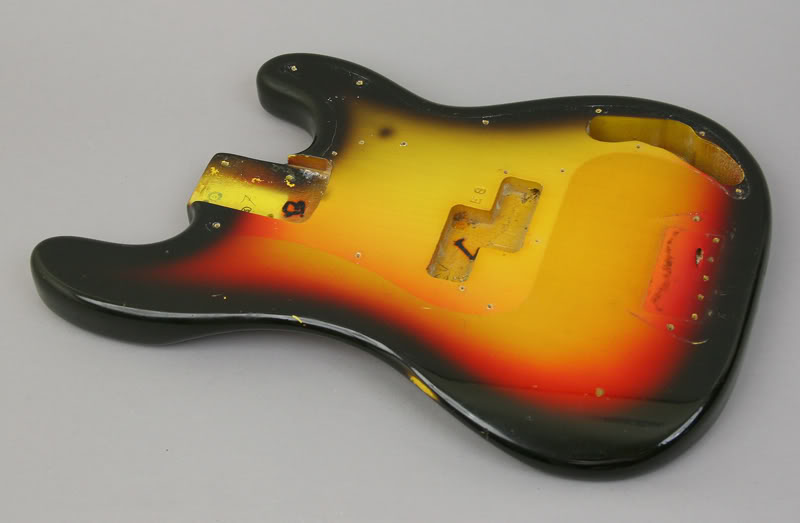
I referred to both pictures of vintage Fenders and to the 70s P-bass body as a guide for the shape and width of the red portion of the burst. If you examine pictures from the 60s, you will notice that there was a substantial variation in the width of both the red and walnut portions of the 3-color burst. In addition, the red portion of the burst has often faded over the years from exposure to UV, and most likely was wider than you'd think when it was originally applied to your vintage instrument. Notice how there is some red UNDER the guard of this 65 P-bass body - the amount of fade is obvious.
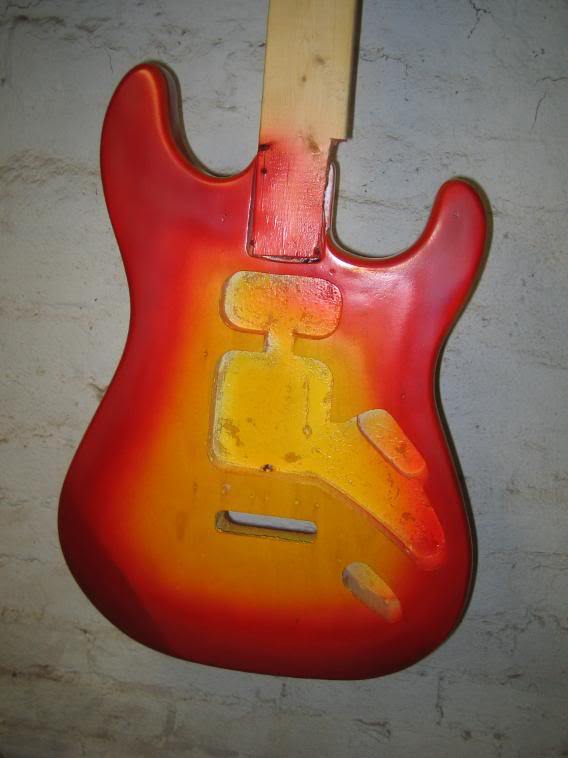
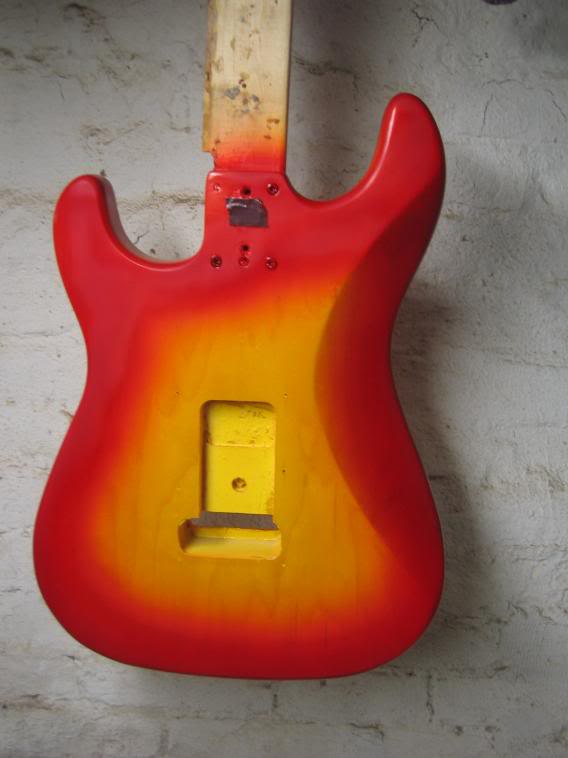
I tinted clear gloss nitro heavily with straight cherry red dye - the same color I use for doing a Gibson cherry red and for the red on a candy apple red - it seems to be the all purpose red that both Gibson and Fender used during the 60s and 70s. Using my detail HVLP gun and fairly low pressure, I outlined the edges of the body, angling my spraying outwards such that overspray would go away from the body.
I slowly built up the density and width of the red area - I didn't really bother trying to get the edges of the body completely red, as the walnut would cover these areas eventually.
When I finished, the red portion had a distinct "orange" look to it - in fact, the finish looked almost identical to the "Sienna Burst" finish Fender used on some budget models in the early 60s and then reintroduced on the P-bass and Strat in the late 70s. I avoided my temptation to darken the red further, either by tinting more heavily or adding some brown to the mix.

I was now ready for the "black" part of the 3-color burst - in reality a dark dark walnut tint. I considered masking off the front and back of the body while I painted just the edges, but then decided against as I was sure that was NOT how Fender did it. In the end this was a key decision.
I once again used a clear gloss nitro base, heavily tinting with dark walnut dye - I did some test sprays on scrap paper to get a good density of color and used a fairly low pressure, but no so low that I would get "sputtering".
My first set of passes were aimed at the edges of the body, angled again so that any overspray would go away from the body - it took a number of passes to get a truly opaque edge to the 3 color burst. I also began to "draw" the outside border around the front and back edges of the body - keeping them fairly narrow - figuring that I could always widen them out later.
I let the body dry for about 30 minutes so that I could really asses what I had. What I noticed was that despite my efforts at avoiding overspray, there was an ever so light dusting of walnut over the front and back of the body - which PERFECTLY deepened both the red and the yellow to the true "Fender" colors !! (sorry about the blurry back photo - oops!)
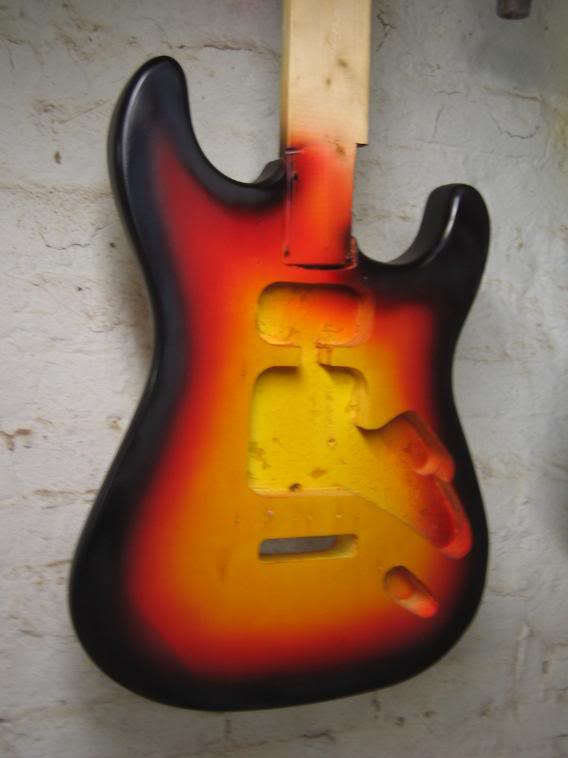
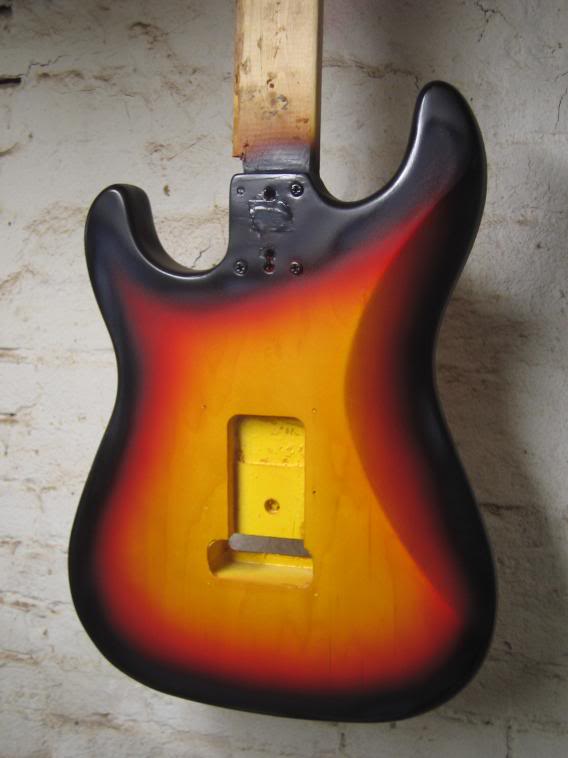

Now it was time for for the final layer of walnut finish. Using the trusty old P-bass body as a guide - I did my best to duplicate the contours and width of the dark portion of the burst - resulting in the finish you see in the last two pictures. For comparison, I have also included a picture of the back of the P-bass body.
To complete the finish, the 3 color burst was clear coated a number of times - roughly 5 clear nitro lacquer coats - I wanted to be sure when I wet sanded the body I didn't cut into the relatively thin sunburst portion of the finish.
While I was waiting for the clear coats to dry - I got to work on the custom pickguard the owner had requested. He wanted a pearloid laminate guard - I ordered the material from Warmoth - an Italian-made product that was labeled all over the place as "highly flammable" - good old school stuff !!!
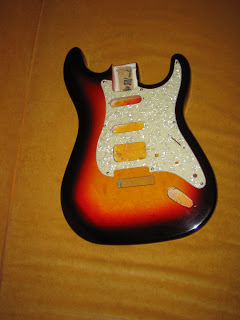
To make the guard, I first made a master from 1/4 inch thick masonite, using the original white plastic guard as a guide. Then I taped the rough cut pearloid material to the form, and cut the guard to shape using two bearing equipped routers - a beveled router for the edges and straight one for the internal cuts and cutout for the neck and tremelo. A little file work was required afterward, followed by some sanding of the edges, but the guard came out very nice - good thing since the raw material cost over $40 !!
Once the clear coats had dried for several weeks, I finally wet sanded the entire body - beginning with 400 grit and working up to 1200 grit, before using two buffing compounds and the Meguir's ScratchX for the final hand polishing. The finish really took on a deep shine and looks even more like a well-preserved vintage sunburst now.
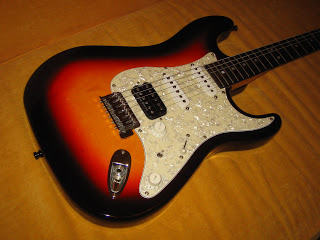
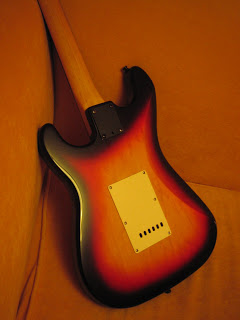
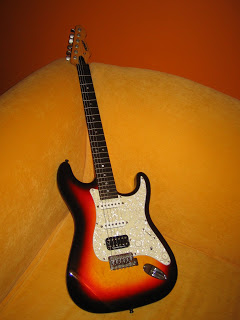
- 1976 Fender Precision Bass: Refinish To Lake Placid Blue - A Classic 60s Color!
This is a fairly straight forward refinish of a stripped Fender Precision bass body in one of Fender's classic 1960s custom colors, Lake Placid Blue. As with all of the Fender custom colors of the 60s, Lake Placid Blue was originally a car color for...
- 1966 Fender Jazzmaster: Aged Olympic White
< A fairly straightforward project here - a 1966 Fender Jazzmaster body that had been poorly refinished over the years and that the owner wanted to do in an aged Olympic White finish. The original Olympic White is a color thats seldom seen - its a bright...
- G&l L-2000 Tribute Bass, In Fender Style Antigua! Does Anybody Remember The 70s ...??
My bass buddy Steve (actually I have a few bass buddies named Steve ..) approached me with the idea of refinishing his recent G&L L-2000 bass in something more interesting than the factory sunburst with walnut back finish it had. This bass is one of the...
- G&l L1000 Bass - Partial Refinish
Another project that has recently come my way - an early 80s G&L L-1000 bass with a mahogany body and a transparent brown or mocha finish - that has suffered from some sort of finish deterioration on the front face only. The pits in the finish actually...
- G&l Asat Bass Refinish
Ok some of you may wince, because this bass had a very nicely done factory cherry sunburst finish when I started on it, but the owner simply didn't like it and wanted something brighter and louder and more ... ORANGE !!! This is a very cool bass -...
Guitar
Peavey Predator Refinish to Fender 3-color Sunburst:Completed!!

This post will hopefully guide the reader through the entire process for doing an accurate 1960s style Fender 3-color sunburst finish.
A customer asked me if it was possible to refinish his cream white Peavey Predator in a classic Fender-style 3-color sunburst. I explained that it might not be possible if I couldn't cleanly strip the existing finish off the Peavey and also, I had no idea what kind of wood was under the existing finish. We agreed that once I made an attempt at stripping the body we would talk and re-evaluate the options - the backup plan was to spray a Daphne Blue finish on the body.
The first step was to strip the body - always my least favorite step. I was pleasantly surprised when the cream finish did bubble up and peel away. The underlying primer coat was a little tougher, but eventually most of it came off, leaving some white finish on the body edges and cutaways.
A bit more hand sanding and a few passes with a random orbital sander cleaned up the body nicely - revealing a veneered birch or maple top and back. The only issue was at the front and back contours, which were obviously not veneered and therefore had a slightly different appearance.


Much of the factory sealer coat was still on the wood, so a few coats of clear nitro were applied, rather than the vinyl undercoat that would be required on bare wood. After these coats were lightly sanded, the first tinted coat was applied - the base of the 3-color sunburst. This coat was clear gloss nitro tinted with equal parts of vintage amber and lemon yellow dye, with a drop of orange added. Several coats were sprayed till an even fairly rich color was achieved - though it still looked lighter and brighter than I was accustomed to seeing on 3-color Fenders.
A clear coat was applied over this, so that if I messed up the next two colors of the burst I would have the option of wetsanding off those coats and giving it another try. The body was lightly wet sanded to remove and unevenness and smooth out any orange peel.

For the next step - I used an old beat up early 70's P-bass body as a reference. I was fairly certain that the sequence of finishing was: yellow, red, then walnut - but one site (maybe ReRanch) implied that the red could be done AFTER the walnut. However, the worn edges of the P-bass clearly illustrate a BRIGHT cherry red layer UNDER the almost black edge color.

I referred to both pictures of vintage Fenders and to the 70s P-bass body as a guide for the shape and width of the red portion of the burst. If you examine pictures from the 60s, you will notice that there was a substantial variation in the width of both the red and walnut portions of the 3-color burst. In addition, the red portion of the burst has often faded over the years from exposure to UV, and most likely was wider than you'd think when it was originally applied to your vintage instrument. Notice how there is some red UNDER the guard of this 65 P-bass body - the amount of fade is obvious.


I tinted clear gloss nitro heavily with straight cherry red dye - the same color I use for doing a Gibson cherry red and for the red on a candy apple red - it seems to be the all purpose red that both Gibson and Fender used during the 60s and 70s. Using my detail HVLP gun and fairly low pressure, I outlined the edges of the body, angling my spraying outwards such that overspray would go away from the body.
I slowly built up the density and width of the red area - I didn't really bother trying to get the edges of the body completely red, as the walnut would cover these areas eventually.
When I finished, the red portion had a distinct "orange" look to it - in fact, the finish looked almost identical to the "Sienna Burst" finish Fender used on some budget models in the early 60s and then reintroduced on the P-bass and Strat in the late 70s. I avoided my temptation to darken the red further, either by tinting more heavily or adding some brown to the mix.

I was now ready for the "black" part of the 3-color burst - in reality a dark dark walnut tint. I considered masking off the front and back of the body while I painted just the edges, but then decided against as I was sure that was NOT how Fender did it. In the end this was a key decision.
I once again used a clear gloss nitro base, heavily tinting with dark walnut dye - I did some test sprays on scrap paper to get a good density of color and used a fairly low pressure, but no so low that I would get "sputtering".
My first set of passes were aimed at the edges of the body, angled again so that any overspray would go away from the body - it took a number of passes to get a truly opaque edge to the 3 color burst. I also began to "draw" the outside border around the front and back edges of the body - keeping them fairly narrow - figuring that I could always widen them out later.
I let the body dry for about 30 minutes so that I could really asses what I had. What I noticed was that despite my efforts at avoiding overspray, there was an ever so light dusting of walnut over the front and back of the body - which PERFECTLY deepened both the red and the yellow to the true "Fender" colors !! (sorry about the blurry back photo - oops!)



Now it was time for for the final layer of walnut finish. Using the trusty old P-bass body as a guide - I did my best to duplicate the contours and width of the dark portion of the burst - resulting in the finish you see in the last two pictures. For comparison, I have also included a picture of the back of the P-bass body.
To complete the finish, the 3 color burst was clear coated a number of times - roughly 5 clear nitro lacquer coats - I wanted to be sure when I wet sanded the body I didn't cut into the relatively thin sunburst portion of the finish.
While I was waiting for the clear coats to dry - I got to work on the custom pickguard the owner had requested. He wanted a pearloid laminate guard - I ordered the material from Warmoth - an Italian-made product that was labeled all over the place as "highly flammable" - good old school stuff !!!
To make the guard, I first made a master from 1/4 inch thick masonite, using the original white plastic guard as a guide. Then I taped the rough cut pearloid material to the form, and cut the guard to shape using two bearing equipped routers - a beveled router for the edges and straight one for the internal cuts and cutout for the neck and tremelo. A little file work was required afterward, followed by some sanding of the edges, but the guard came out very nice - good thing since the raw material cost over $40 !!
Once the clear coats had dried for several weeks, I finally wet sanded the entire body - beginning with 400 grit and working up to 1200 grit, before using two buffing compounds and the Meguir's ScratchX for the final hand polishing. The finish really took on a deep shine and looks even more like a well-preserved vintage sunburst now.
- 1976 Fender Precision Bass: Refinish To Lake Placid Blue - A Classic 60s Color!
This is a fairly straight forward refinish of a stripped Fender Precision bass body in one of Fender's classic 1960s custom colors, Lake Placid Blue. As with all of the Fender custom colors of the 60s, Lake Placid Blue was originally a car color for...
- 1966 Fender Jazzmaster: Aged Olympic White
< A fairly straightforward project here - a 1966 Fender Jazzmaster body that had been poorly refinished over the years and that the owner wanted to do in an aged Olympic White finish. The original Olympic White is a color thats seldom seen - its a bright...
- G&l L-2000 Tribute Bass, In Fender Style Antigua! Does Anybody Remember The 70s ...??
My bass buddy Steve (actually I have a few bass buddies named Steve ..) approached me with the idea of refinishing his recent G&L L-2000 bass in something more interesting than the factory sunburst with walnut back finish it had. This bass is one of the...
- G&l L1000 Bass - Partial Refinish
Another project that has recently come my way - an early 80s G&L L-1000 bass with a mahogany body and a transparent brown or mocha finish - that has suffered from some sort of finish deterioration on the front face only. The pits in the finish actually...
- G&l Asat Bass Refinish
Ok some of you may wince, because this bass had a very nicely done factory cherry sunburst finish when I started on it, but the owner simply didn't like it and wanted something brighter and louder and more ... ORANGE !!! This is a very cool bass -...
